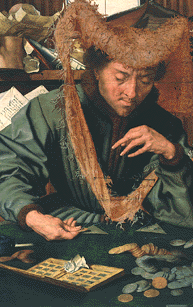|
Scotland has the peculiar honor of being the home to two great, competing theories of money: the "real bills" doctrine and the "quantity theory" doctrine. The real bills doctrine was initiated by the Scotsman-turned-Frenchman, John Law (1705) and further developed by two other Scotsmen, Sir James Steuart (1767) and Adam Smith (1776). Yet we also find one of the better statements of the quantity theory of money in the work of another Scotsmen, David Hume (1752). Both these theories were fought out in England during the Bullionist debates of the early 1800s. David Hume, as noted in our opening quote, initiated the famous "oil-in-the-machine" illustration of the neutrality of money. He outlined the famous Quantity Theory relationship between supply of money and prices quite explicitly:
Naturally, Hume's ideas have older roots: the direct "quantity theory" relationship between money and prices as we noted, was introduced by Jean Bodin and the theory itself was due to John Locke. However, the bulk of the Mercantilists equated money with wealth. Thus, David Hume's adamant stress upon the idea of money as a "veil" must be regarded in the light of his attempt to assail Mercantilism in general. Adam Smith seemed to agree with Hume in part. For instance, he writes:
Thus, both Hume and Smith thus believed money was of no direct consequence on the "real" economy other than improving upon its efficiency. This is where they saw the "why" of money. But Adam Smith nurtured two peculiarities in his theory of money which distinguished him from both David Hume and the Classical theorists. Firstly, Smith also argued (1776: p.37-8) that money facilitates division of labor. But division of labor, in Smith's theory, improves real output growth, thus one might claim that there was some degree of "non-neutrality" in his idea of money; his repeated referral to money as "a very valuable part of capital" but which "makes no part of the revenue of the society" (Smith, 1776: p.291) is an illustration of an ambiguous attitude towards the concept of a "veil". Secondly, as noted, Smith was also the developer of the "Real Bills" doctrine of money, which makes his theory rather distinct from both Hume and the Classical economists and closer to the older pre-classical theories of Davanzati, John Law and Sir James Steuart. The "Real Bills" theory essentially argued that the supply of money is not "exogenous" (as Hume thought) but rather "endogenous": banks "create" money according to the needs of trade. Thus, in a sense, Smith did not really think increased supplies of money led to higher prices because his Real Bills doctrine would claim that supply of money could not be increased exogenously to begin with. One can think that the Elizabethan Inflation would be explained differently by Hume and Smith: Hume would say it was the influx of American gold that "caused" inflation, but Smith would say it was the greater needs of trade in Europe that caused a higher demand for goods and thus inflation - and that the higher "need" for specie by which to conduct this greater amount of trade that thereby led to the importation of gold and the expansion of money supply. (Smith did not really say this himself so explicitly, but other advocates of the Real Bills doctrine did - as this is what it implies. See our discussion of the Bullionist Debates). |
All rights reserved, Gonšalo L. Fonseca

